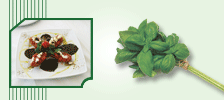
Local Products
Santorini soil is common to most Cycladic islands, which is volcanic and stony. It is however especially fertile for the raw materials and products only available in the island such as wine varieties, anhydrous cherry tomatoes, peas pudding, white aubergines and katsounia.
Wine
The volcanic ground of Santorini, in combination with little rainfall, and strong winds render Santorini wine yards unique and of world stature. The main characteristic
of viniculture you find on the island is found in the blastus of the plant which has a ring shape, allowing it to grow in small levels to protect it from the winds.
Harvesting, known in Santorini as Ventema, deriving from the Italian language, takes place every August and September and constitutes for the Thirians an annual ritual where all members of the family take part.
Many varieties of wine are prepared from the unique range of grapes of the island: the nihteri for instance which is named after night as the juice of the grapes is deducted at night time, the Asyrtiko and the AIdani.
Santorini with the incomparable sun cured wine attracts attention, and the scents of the wines include honey, sultanas, nuts and figs bring back memories of the wooden doors of the manor houses which are rarely locked.
The famous Vinsanto ( Vino Santo) with the protected name of origin, is used for the communion of the Catholic church. The alcohol volume of Vinsanto normally does not exceed 12%, while its aroma is easily distinguished in the first two years of ageing which takes place in tilted bottles and oak installations.
Anhydrous Cherry Tomatoes
The anhydrous cherry tomatoes of Santorini are a very special produce with a particular interesting history. This variety originates from Egypt, and found in Santorini the ideal fertile anhydrous environment. How it came to Santorini gets lost in the legend that it was first brought by a monk who taught the Santorinians the secrets of its cultivation. The most probable scenario however is that Santorinian seamen brought it to the island after providing Santorinian soil for the creation of the Souez canal. Because of the anhydrous ground the small tomato which doesn't grow larger than a cherry, has such a flavorsome quality, that formerly there were up to 10 factories which produced and exported the tomato puree. Especially in the beginning of the 20th Century the Santorinian tomato was the major export product of Thira as well as the soil. The industry was however impaired by the competition which the low production in terms of land expanse could not match. The earthquake of 1956 stopped its mass production altogether.
Today the cherry tomato is one of the characteristic products of Santorini and the island still maintains a factory of production of puree of the Santorini union. The tomato is also used to make fresh salads and the marvelous cherry tomato balls (tomatokeftedes).
Peace pudding
Santorini pease pudding is regarded as one of the best products of the island. It is collected from the plant called 'arakas' and according to ancient findings at the area of Akrotiri, it's cultivation on the island has exceeded 3500 years. The traditional process methods give the pease pudding its authenticity and naturally its distinctive flavor. The seed semination takes place in late December and its crop in June. The natural elaboration follows which involves letting it mature for a year in underground storehouses, letting it dry in the sun, cleaning it, decortication and lastly cutting it.
The white aubergine
The white aubergine another crop of the island, is also said to have derived from Egypt through commercial exporting of pumice for the opening of the SOUEZ canal. Due to the distinctiveness of the Santorini ground, it does not have the bitterness of aubergines, on the contrary it is sweet and juicy, with few seeds and is usually cooked or fried.
Katsounia
The Santorini ground as well as the climate aids the growth of the katsouni, a sweet and flavorful cucumber. It is larger, thicker and lighter colored than the common cucumber. If not collected on time its green color turns yellow and its taste sweetens, reminding a melon.
Useful Info
 Shopping
Shopping Architecture
Architecture Entertainment
Entertainment Food
Food The Volcano
The Volcano History
History Morals and customs
Morals and customs Beach
Beach Access
Access Transportation
Transportation Useful Info
Useful Info Local Products
Local Products


